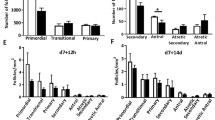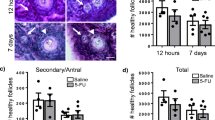Abstract
Purpose
Tyrosine kinase inhibitors (TKIs) such as imatinib are commonly used chemotherapeutics, but the effects of long-term treatments on reproductive outlook for cancer survivors are unknown. The purpose of this study was to examine the effects of long-term imatinib treatments on follicle development and embryo quality. Since prospective studies are not possible in healthy humans, we have incorporated a commonly used mouse model.
Methods
Adult female mice were treated with daily IP injections of imatinib for 4–6 weeks. Liquid chromatography-mass spectrometry was used to measure imatinib in serum and ovarian tissues. At the end of treatments, females were superovulated and mated to yield fertilized embryos. Oocytes and embryos were collected from oviducts, assessed for development by microscopy, and fertilized embryos were cultured in vitro. Blastocysts were fixed and stained for differential cell counts.
Results
Long-term imatinib treatments caused a shift in follicle development, with imatinib-treated females having fewer primordial follicles, but an increase in primary and secondary follicles (P < 0.05). There was no effect on ovulation or fertilization rates. However, blastocysts from imatinib-treated females had fewer total cells (P < 0.05) and a significant shift from inner cell mass to increased trophectoderm cells.
Conclusion
This pilot study indicates that long-term TKI treatments may have significant impact on ovarian reserve and embryo developmental capacity. More studies are needed in other model systems to determine the long-term impact of TKIs in patients. Knowing the potential effects of chemotherapeutics on reproductive outlook is critical for quality of life and more research is needed.



Similar content being viewed by others
References
Levine J, Canada A, Stern CJ. Fertility preservation in adolescents and young adults with cancer. J Clin Oncol. 2010;28:4831–41.
Zeltzer LK. Cancer in adolescents and young-adults psychosocial-aspects—long-term survivors. Cancer. 1993;71:3463–8.
Oncology ASoC. American Society of Clinical Oncology recommendations on fertility preservation in cancer patients. J Clin Oncol. 2006;24:5790.
Goel N, Malik R, Rathi B, Bhaskaran S, Rajaram S, Mehta S, et al. Pregnancy with metastatic gastrointestinal stromal tumor (GIST) on imatinib chemotherapy: an oncologist’s nightmare and obstetrician’s dilemma. J Gastrointest Cancer. 2013;44:115–7.
Bernard V, Bouilly J, Kramer P, Carre N, Schlumberger M, Visser JA, et al. The tyrosine kinase inhibitor sunitinib affects ovulation but not ovarian reserve in mouse: a preclinical study. PLoS One. 2016;11:e0152872.
Steegmann JL, Cervantes F, le Coutre P, Porkka K, Saglio G. Off-target effects of BCR-ABL1 inhibitors and their potential long-term implications in patients with chronic myeloid leukemia. Leuk Lymphoma. 2012;53:2351–61.
Rausch JL, Boichuk S, Ali AA, Patil SS, Liu L, Lee DM, et al. Opposing roles of KIT and ABL1 in the therapeutic response of gastrointestinal stromal tumor (GIST) cells to imatinib mesylate. Oncotarget. 2017;8:4471–83.
Melaiu O, Catalano C, De Santi C, Cipollini M, Figlioli G, Pelle L, et al. Inhibition of the platelet-derived growth factor receptor beta (PDGFRB) using gene silencing, crenolanib besylate, or imatinib mesylate hampers the malignant phenotype of mesothelioma cell lines. Genes Cancer. 2017;8:438–52.
Zitvogel L, Rusakiewicz S, Routy B, Ayyoub M, Kroemer G. Immunological off-target effects of imatinib. Nat Rev Clin Oncol. 2016;13:431–46.
Yoon SJ, Kim KH, Chung HM, Choi DH, Lee WS, Cha KY, et al. Gene expression profiling of early follicular development in primordial, primary, and secondary follicles. Fertil Steril. 2006;85:193–203.
Sleer LS, Taylor CC. Cell-type localization of platelet-derived growth factors and receptors in the postnatal rat ovary and follicle. Biol Reprod. 2007;76:379–90.
Carlsson IB, Laitinen MP, Scott JE, Louhio H, Velentzis L, Tuuri T, et al. Kit ligand and c-Kit are expressed during early human ovarian follicular development and their interaction is required for the survival of follicles in long-term culture. Reproduction. 2006;131:641–9.
Hutt KJ, McLaughlin EA, Holland MK. Kit ligand and c-Kit have diverse roles during mammalian oogenesis and folliculogenesis. Mol Hum Reprod. 2006;12:61–9.
Nilsson EE, Detzel C, Skinner MK. Platelet-derived growth factor modulates the primordial to primary follicle transition. Reproduction. 2006;131:1007–15.
Pascuali N, Scotti L, Abramovich D, Irusta G, Di Pietro M, Bas D, et al. Inhibition of platelet-derived growth factor (PDGF) receptor affects follicular development and ovarian proliferation, apoptosis and angiogenesis in prepubertal eCG-treated rats. Mol Cell Endocrinol. 2015;412:148–58.
McGinnis LK, Carroll DJ, Kinsey WH. Protein tyrosine kinase signaling during oocyte maturation and fertilization. Mol Reprod Dev. 2011;78:831–45.
Christopoulos C, Dimakopoulou V, Rotas E. Primary ovarian insufficiency associated with imatinib therapy. N Engl J Med. 2008;358. United States:1079–80.
Zamah AM, Mauro MJ, Druker BJ, Oktay K, Egorin MJ, Cedars MI, et al. Will imatinib compromise reproductive capacity? Oncologist. 2011;16:1422–7.
Salem W, Li K, Krapp C, Ingles SA, Bartolomei MS, Chung K, et al. Imatinib treatments have long-term impact on placentation and embryo survival. Sci Rep. 2019;9:2535.
Biggers JD, McGinnis LK. Evidence that glucose is not always an inhibitor of mouse preimplantation development in vitro. Hum Reprod. 2001;16:153–63.
Petzer AL, Wolf D, Fong D, Lion T, Dyagil I, Masliak Z, et al. High-dose imatinib improves cytogenetic and molecular remissions in patients with pretreated Philadelphia-positive, BCR-ABL-positive chronic phase chronic myeloid leukemia: first results from the randomized CELSG phase III CML 11 “ISTAHIT” study. Haematologica. 2010;95:908–13.
Rezende VM, Rivellis AJ, Gomes MM, Dorr FA, Novaes MM, Nardinelli L, et al. Determination of serum levels of imatinib mesylate in patients with chronic myeloid leukemia: validation and application of a new analytical method to monitor treatment compliance. Rev Bras Hematol Hemoter. 2013;35:103–8.
Wolf A, Couttet P, Dong M, Grenet O, Heron M, Junker U, et al. Imatinib does not induce cardiotoxicity at clinically relevant concentrations in preclinical studies. Leuk Res. 2010;34:1180–8.
Kong X, Yang S, Gong F, Lu C, Zhang S, Lu G, et al. The relationship between cell number, division behavior and developmental potential of cleavage stage human embryos: a time-lapse study. PLoS One. 2016;11:e0153697.
Biggers JD, McGinnis LK, Raffin M. Amino acids and preimplantation development of the mouse in protein-free potassium simplex optimized medium. Biol Reprod. 2000;63:281–93.
Schultheis B, Nijmeijer BA, Yin H, Gosden RG, Melo JV. Imatinib mesylate at therapeutic doses has no impact on folliculogenesis or spermatogenesis in a leukaemic mouse model. Leuk Res. 2012;36:271–4.
Kalich-Philosoph L, Roness H, Carmely A, Fishel-Bartal M, Ligumsky H, Paglin S, et al. Cyclophosphamide triggers follicle activation and “burnout”; AS101 prevents follicle loss and preserves fertility. Sci Transl Med. 2013;5:185ra162.
Cole S, Kantarjian H, Ault P, Cortes JE. Successful completion of pregnancy in a patient with chronic myeloid leukemia without active intervention: a case report and review of the literature. Clin Lymphoma Myeloma. 2009;9:324–7.
Abruzzese E, Trawinska MM, Perrotti AP, De Fabritiis P. Tyrosine kinase inhibitors and pregnancy. Mediterr J Hematol Infect Dis. 2014;6:e2014028.
Ault P, Kantarjian H, O'Brien S, Faderl S, Beran M, Rios MB, et al. Pregnancy among patients with chronic myeloid leukemia treated with imatinib. J Clin Oncol. 2006;24:1204–8.
O'Brien S, Berman E, Borghaei H, Deangelo DJ, Devetten MP, Devine S, et al. NCCN clinical practice guidelines in oncology: chronic myelogenous leukemia. J Natl Compr Cancer Netw. 2009;7:984–1023.
Branford S, Yeung DT, Ross DM, Prime JA, Field CR, Altamura HK, et al. Early molecular response and female sex strongly predict stable undetectable BCR-ABL1, the criteria for imatinib discontinuation in patients with CML. Blood. 2013;121:3818–24.
Baccarani M, Cortes J, Pane F, Niederwieser D, Saglio G, Apperley J, et al. Chronic myeloid leukemia: an update of concepts and management recommendations of European LeukemiaNet. J Clin Oncol. 2009;27:6041–51.
Acknowledgments
A special thank you to Dr. Dennis Koop and Ms. Jenny Luo from the OHSU Bioanalytical Shared Resource/Pharmacokinetics Core for assistance with the LC-MS/MS analysis. The facility is part of the University Shared Resource Program supported by Oregon Health and Sciences University.
Funding
This research was supported by Grant No. IRG-58-007-54 from the American Cancer Society with pilot funding awarded to LKM; a fellowship research award from the Goldhirsh-Yellin Foundation to WS; and USC Norris Cancer Center Grant No. 2P30CA014089-43.
Author information
Authors and Affiliations
Contributions
All authors were involved in the initial planning of the research, reviewing frequent updates on the research progress, reviewing the data results, and writing the manuscript. LKM and WS treated the animals; LKM and IW conducted the cultures; WS counted follicles; LKM graded embryo development and counted blastocyst cells; SAI reviewed study designs and conducted the statistical analysis; IW, WA, and LKM drafted the manuscript; JRH, KC, and RJP reviewed all of the proposed research, critically evaluated the data, and contributed to the writing of the manuscript.
Corresponding author
Ethics declarations
All experiments were conducted in accordance with the “Guide for the Care and use of laboratory Animals” and preapproved by the University of Southern California Institutional Animal Care and Use Committee.
Additional information
Publisher’s note
Springer Nature remains neutral with regard to jurisdictional claims in published maps and institutional affiliations.
Rights and permissions
About this article
Cite this article
Salem, W., Ho, J.R., Woo, I. et al. Long-term imatinib diminishes ovarian reserve and impacts embryo quality. J Assist Reprod Genet 37, 1459–1466 (2020). https://doi.org/10.1007/s10815-020-01778-7
Received:
Accepted:
Published:
Issue Date:
DOI: https://doi.org/10.1007/s10815-020-01778-7




